Over the past few decades, a revolution has taken place at the ballot box. Activists have legalized cannabis, gay marriage, and even phased out battery cages, veal crates, and gestation crates using the purest form of direct democracy: ballot initiatives.
In 24 states and many localities, citizens can propose laws and vote directly to enact them. Lately, a bolder question is gaining ground: can US citizens use ballot initiatives to dismantle factory farming altogether?
At Pro-Animal Future, we’re banking on the answer being yes. The way we see it, it’s not only theoretically possible but also our moral imperative to try.
We believe that factory farming is one of the greatest atrocities ever committed by humankind. Animals on industrial farms are routinely kept in extreme confinement—hens packed in cages, pigs trapped in crates, ducks crowded into windowless sheds—conditions that are almost entirely hidden from public view. In theory, ballot initiatives give us (the voters) a chance to outlaw this practice directly, overriding the influence agribusiness has on our legislators and shifting the cultural and legal consensus to be more pro-animal.
Transformative Social Change Has Never Come Easily

Building support for controversial social issues like animal freedom through the initiative process is akin to a slow burn, because winning the popular vote requires buy-in from the public, and it can take time for public opinion to shift.
For example, it took decades of ballot campaigns to legalize cannabis in most states. In 2006, most Americans told Pew Research that using cannabis was immoral. Fast forward to 2018, and that figure had reversed; 65% of Americans now believe that using cannabis is morally acceptable (source). Citizen-initiated ballot measures played a big role in this massive shift in cultural acceptance.
In 1996, a successful ballot measure led to California becoming the first state to legalize weed for medical use. Since then, American voters have had the chance to vote on over 80 statewide ballot initiatives related to cannabis. Some of these initiatives passed and many others failed but today, recreational use is legal 24 US states (and counting).
The animal rights movement shouldn’t expect to be able to make progress as quickly or fundraise as easily as the cannabis industry (at least, for the time being). But what we should expect is to start at the city and county level, learn from each campaign, refine our strategies, and build the support that will eventually make factory farming as politically indefensible as it is morally inexcusable.
Is There Public Support for Banning Factory Farming?
Foundational to this strategy is getting buy-in from the public. A 2021 Sentience Institute study found that 52.7% of Americans are in favor of banning factory farming entirely. When voters are asked directly whether animals deserve better treatment, they consistently say yes. Yet, most people don’t realize that current laws fail to guarantee even the most basic protections.

One reason why I love ballot initiatives is that they have the power to shift public opinion. By engaging voters directly, we’re actively making animals’ interests a matter of democratic urgency and forcing the public to think about what happens to animals inside factory farms and slaughterhouses.
Even failed measures can shift public discourse. Campaigns to ban factory farming have already introduced millions of voters to the realities of modern animal agriculture and forced industry to defend its practices in the public arena.
Recent Attempts to Ban Factory Farming
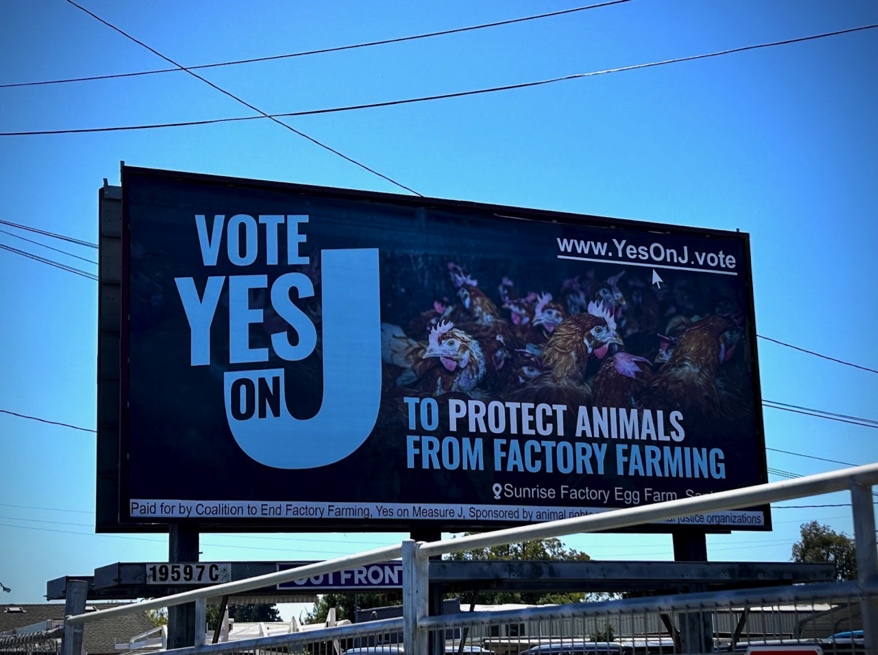
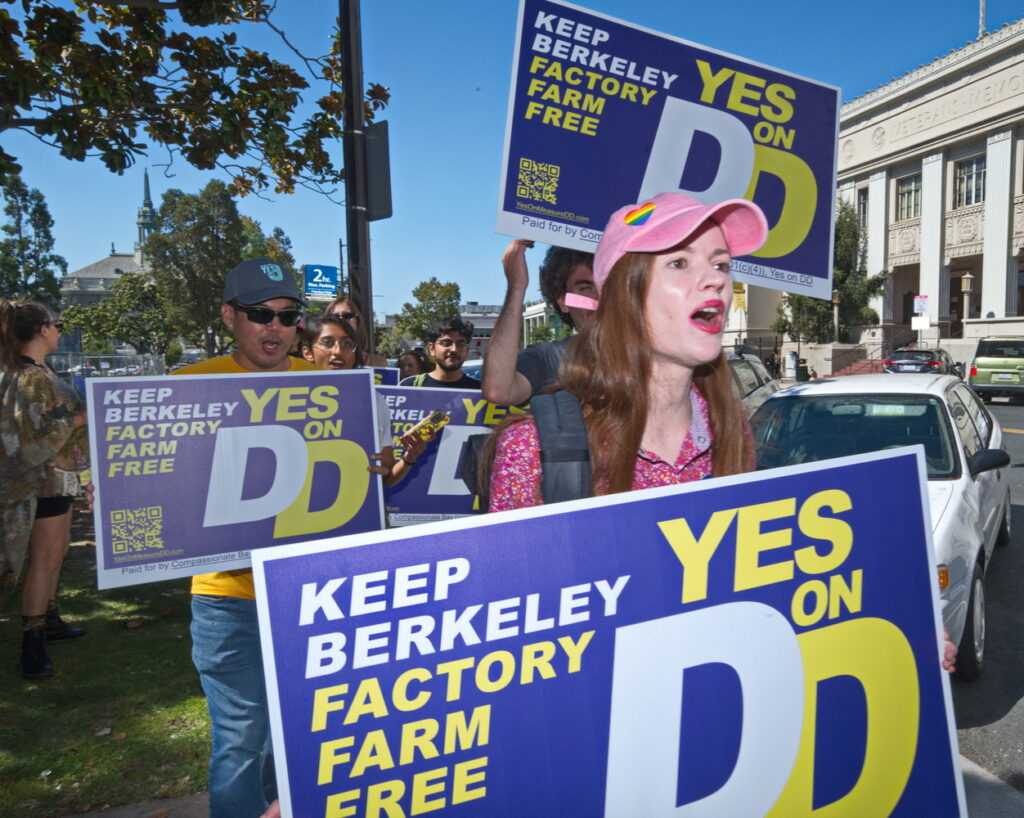
Last year, Berkeley became the first city in the U.S. to ban factory farms. Measure DD passed with 62% of voters voting yes. While somewhat symbolic (the city’s only ‘concentrated animal feeding operation’ closed preemptively to the vote), it sent a powerful message: rallying voters to vote for a factory-farm future is possible.
At the same time, the Coalition to End Factory Farming placed a factory farm ban on the ballot in Sonoma County, California. Unfortunately, Measure J didn’t pass, with 85% of voters opposing it. Unlike Berkeley, Sonoma County has a deeper agricultural heritage, is home to dozens of factory farms, and had a very powerful and well-resourced opposition campaign spread misinformation.
While it wasn’t a factory farm ban, our initiative to ban slaughterhouses in Denver, Colorado was also defeated during the 2024 election, with 64% of voters opposing it. Superior Farms slaughterhouse and industry groups like the Meat Institute and National Pork Producers Council spent over $2M hiring multiple contract lobbyists and PR firms to place negative press pieces, running an expensive print and TV advertising campaign, and soliciting a flawed economic impact report.
It’s not just activists in the United States who are attempting to ban factory farming at the ballot box. In 2022, Switzerland held a national referendum to ban factory farming. Though it failed, over one-third of voters supported it.
It’s understandable that these grassroots coalitions took on mega-factory farms and industrial slaughterhouses for the first time and lost. It’s impressive how successful these campaigns were considering that the industrial animal agriculture lobby represents one of the most formidable political forces in America, wielding vast resources and deep-rooted influence to maintain the status quo.
Power to the People: The Case for Ballot Initiatives
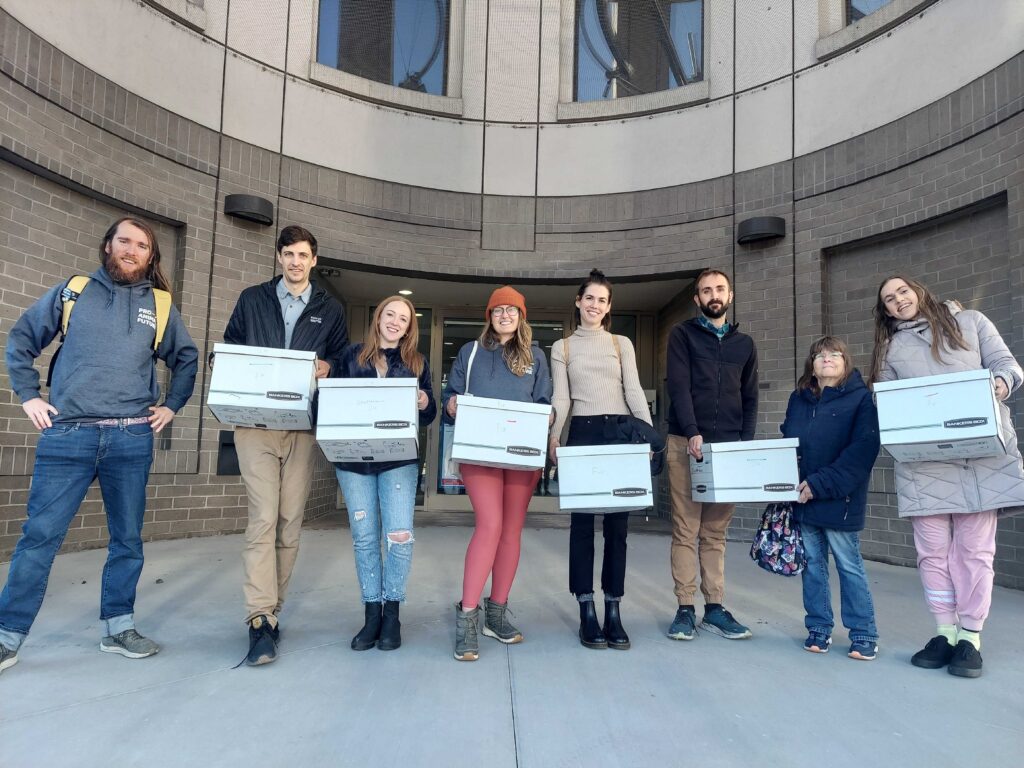
In animal farming states, entrenched ag lobbies often dominate house and senate committees.
Here’s an example. During a recent Pro-Animal Colorado event, a Denver city council legislative aide led a training on lobbying. During the presentation, she referred to Colorado’s ag committee as “the place where good bills go to die”. This committee is known to block even the most modest reforms and we were advised to avoid it at all costs.
Obviously, it’s tricky to pass agricultural reforms through the legislature while bypassing the agricultural committee. So for those instances where lobbying elected officials to pass a law doesn’t work out, ballot measures can be one of the best paths to create real structural change.
Ballot initiatives also serve as powerful educational tools. Unlike quiet legislative changes that happen behind closed doors, ballot campaigns spark widespread public debate—through commercials, door-knocking, yard signs, public debates, and press. During our campaigns to ban fur and slaughterhouses in Denver last year, we had posters on every street corner, 8 massive billboards scattered throughout the city, and we were out on the streets talking to voters nearly every single day. Initiative 309 made it nearly impossible for the public to ignore the issue.
A History of Successful U.S. Farmed Animal Ballot Measures
From Florida to California, voter-led measures have rewritten the rules on how farmed animals can be raised.
- 2002: Florida became the first state to ban gestation crates via ballot, passing Amendment 10 with a modest but significant 54 percent of the vote.
- 2006: Arizona followed with Prop 204, banning both gestation and veal crates with 62% voting yes.
- 2008: California’s Prop 2 required that egg-laying hens, veal calves, and breeding pigs have enough space to turn around and extend their limbs. It passed with 63% support (more than 7.5 million votes) and inspired a wave of corporate policy changes from retailers and food producers nationwide.
- 2016: Massachusetts Question 3 banned cruel confinement within the state and prohibited the sale of any products from animals raised under such conditions, passing with 78% of the vote. Most impressively, the campaign succeeded without paid signature gathering, mobilizing more than 1,000 volunteers to collect over 130,000 signatures.
- 2018: California Prop 12 built upon Prop 2 by codifying square-footage requirements and extending the sales ban to veal, pork, and eggs from non-compliant systems. The measure passed with another 63% of the vote, and its opponents, primarily The Pork Producers Council, took it to the Supreme Court.
- 2023: Prop 12 and Massachusetts Question 3 went into full effect. The court upheld Prop 12 in NPPC v. Ross, affirming that states can regulate the standards of products sold within their borders. This ruling enshrined a powerful legal precedent: voters have the right to enact transformative reforms through the ballot box, even when those reforms affect national supply chains.
- 2024: Measure DD (“Keep Berkeley Factory Farm Free”) passes in Berkeley, California, banning the construction of factory farms in city limits.
Ultimately, these victories have forced the industry to adapt. Egg producers have shifted to cage-free systems in large numbers. Major retailers have revised their sourcing requirements. Gestation crates are being phased out across the nation. The real impact of these ballot initiatives is measured by not only the number of animals who suffer a bit less, but by shifting the baseline of what voters expect and what the industry can get away with.
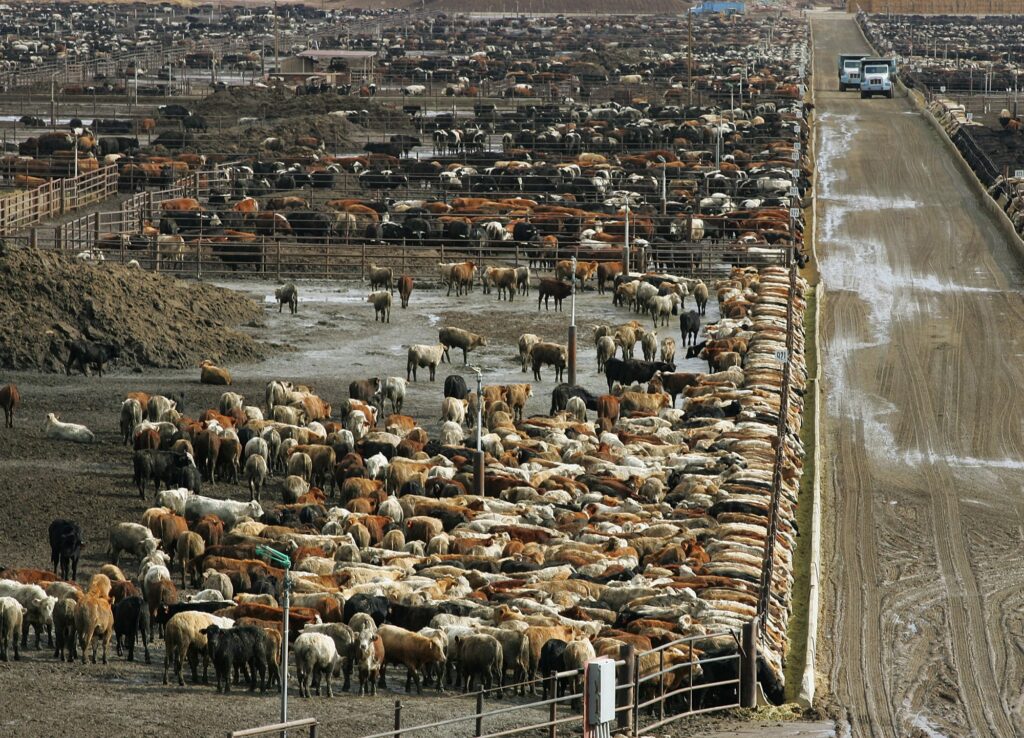
What are ‘Right to Farm’ Laws?
Right-to-Farm (RTF) laws, originally designed to protect small farms from suburban sprawl and nuisance lawsuits, now serve as a legal shield for industrial agriculture. These laws exist in all 50 states and are increasingly used to block local governments and citizens from regulating large-scale animal feeding operations. Although these laws haven’t been fully tested against modern factory farm bans, they create serious legal uncertainty.
Still, it’s essential to understand what most RTF laws do and don’t do. The original intent of these statutes was to prevent nuisance lawsuits—such as neighbors suing a farm over odor or noise—not to block new democratically enacted animal protections. Notably, states like California and Massachusetts have RTF laws on the books, yet they didn’t stop Prop 12 or Question 3.
Why? Because these measures were framed strategically—not only regulating confinement practices, but banning the sale of products made under those conditions. The commercial framing allowed them to avoid direct legal conflict with farming operations and withstand court challenges.
Legal scholars also argue that local governments can defend humane farming laws under traditional police powers—public health, environmental protection, and general welfare. Ballot measures that clearly prioritize these goals are better positioned to survive legal attacks. To succeed, we’ll need tightly crafted laws and strong legal teams. Right-to-farm laws don’t make victory impossible, they just make it harder, and more important to get the language right.
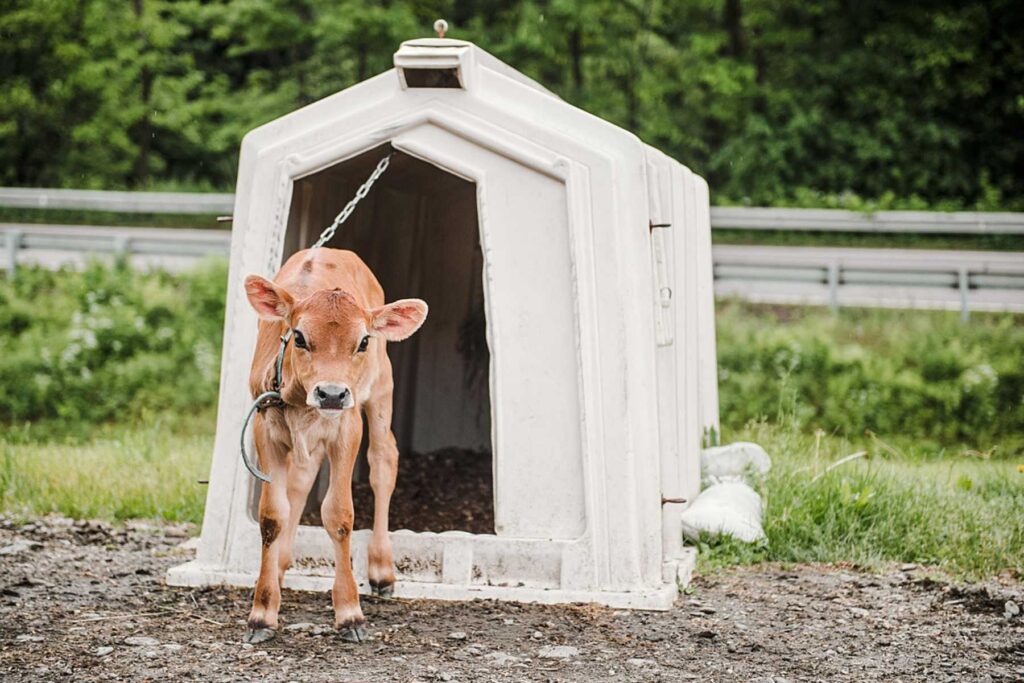
what is the 2025 ‘Farm Security and farm protection Act’?
A more sweeping threat looms at the federal level. On April 8, 2025, lawmakers reintroduced the controversial EATS Act under a new name: the “Farm Security and Farm Protection Act”. This bill aims to strip states and municipalities of their ability to regulate agricultural products sold within their borders, even when those regulations are enacted through democratic ballot initiatives.
If passed, this law could nullify existing animal welfare standards like California’s Prop 12 and Massachusetts’ Question 3, and preempt future efforts to ban factory farms or require humane treatment of animals. It would effectively centralize agricultural regulation at the federal level, overriding the will of voters and local governments.
Proponents argue that this bill would prevent a patchwork of state-wide animal protection laws from ‘disrupting interstate commerce’. That’s exactly what Prop 12 does — it doesn’t allow any products from gestation crates, veal crates, and battery cages to be sold in California (the world’s fifth largest economy).
That’s why the National Pork Producers Council is lobbying the U.S. Congress to dismantle Prop 12. The truth is that the Farm Security and Farm Protection Act undermine states’ rights and democratic processes, allowing industrial agriculture to operate without accountability to local communities.
The rebranding of the EATS Act doesn’t change its core intent: to erode the power of citizens and states to enact meaningful reforms in animal welfare and environmental protection. Email your representatives now and ask them to prevent this federal overreach from undoing hard-won progress. Our strategy to end factory farming and animals lives depend on it.
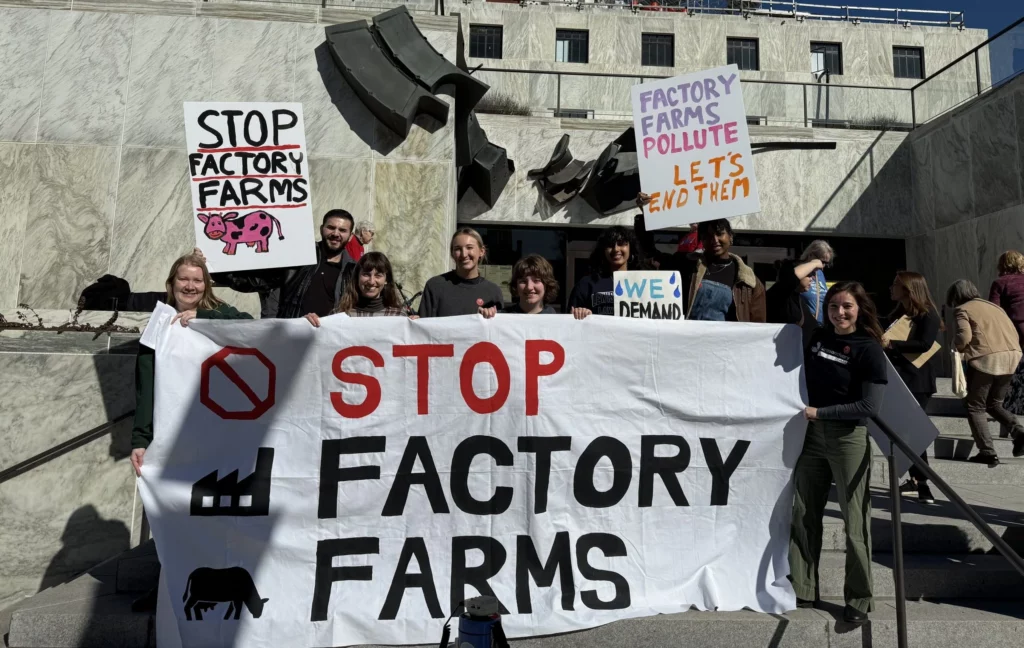
Photo Credit: Farm Sanctuary
OUR Plan to Leverage Direct Democracy
The reality is that phasing out factory farming won’t happen during a short period of time. It will take dozens and dozens of well-crafted ballot initiatives combined with lobbying and other movement tactics, like pressure campaigns, mass media, and undercover investigations.
It’ll require working together with owners of small meat, dairy, and egg farmers, farm workers, and rural community leaders. It’ll require overcoming fierce opposition, big money ad campaigns, and their scare tactics. But if we stay persistent, I believe that over time, we can create a national patchwork of bans and restrictions that collectively dislodge factory farming from its political stronghold.
For the time being, Pro-Animal Future is pivoting our focus towards passing policies with higher levels of voter support. These targeted campaigns (bans on foie gras, fur, etc.) will serve as crucial stepping stones, growing our activist and donor base and demonstrating to voters that banning cruel practices and products is both feasible and popular, ultimately creating the political momentum needed for broader county-wide factory farm bans and statewide reforms.
Every single donation to Pro-Animal Future made by July 31st, 2025 will be matched dollar-for-dollar by a generous grant from the Phauna Foundation. That means your gift goes twice as far towards enabling us to run grassroots ballot measures.
We’re currently fundraising to launch a new chapter in Washington D.C. and kick off signature-gathering in Denver. Our goal is to place citizen initiatives on the 2026 ballot in Denver and the District of Columbia. If you haven’t already, I hope you’ll consider joining taking the leap and becoming a monthly (or one-time) donor to support our campaigns. We can’t do it without you!

